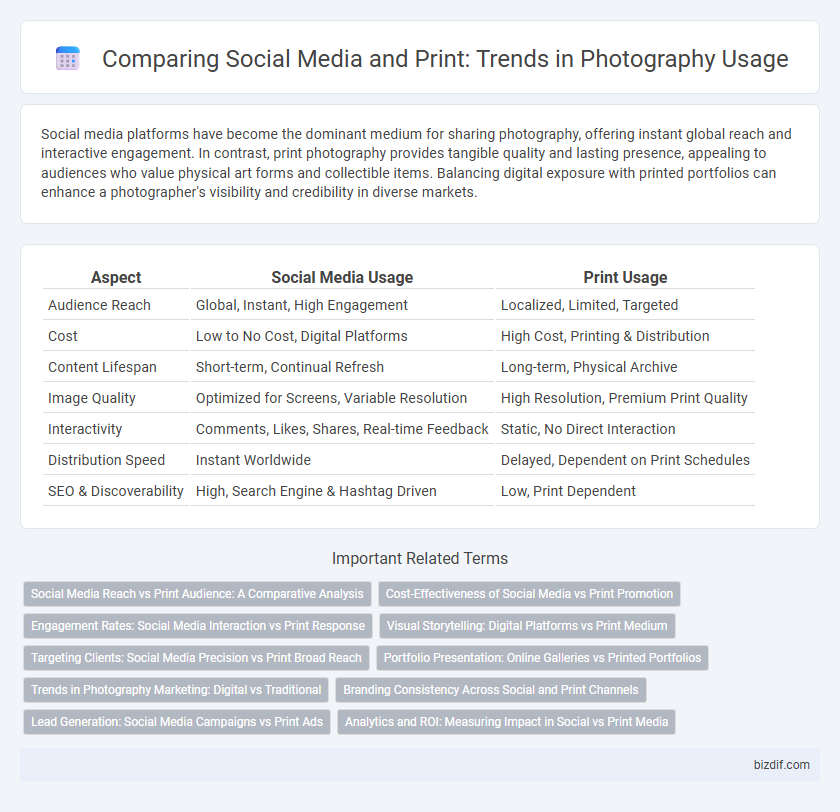Social media platforms have become the dominant medium for sharing photography, offering instant global reach and interactive engagement. In contrast, print photography provides tangible quality and lasting presence, appealing to audiences who value physical art forms and collectible items. Balancing digital exposure with printed portfolios can enhance a photographer's visibility and credibility in diverse markets.
Table of Comparison
| Aspect | Social Media Usage | Print Usage |
|---|---|---|
| Audience Reach | Global, Instant, High Engagement | Localized, Limited, Targeted |
| Cost | Low to No Cost, Digital Platforms | High Cost, Printing & Distribution |
| Content Lifespan | Short-term, Continual Refresh | Long-term, Physical Archive |
| Image Quality | Optimized for Screens, Variable Resolution | High Resolution, Premium Print Quality |
| Interactivity | Comments, Likes, Shares, Real-time Feedback | Static, No Direct Interaction |
| Distribution Speed | Instant Worldwide | Delayed, Dependent on Print Schedules |
| SEO & Discoverability | High, Search Engine & Hashtag Driven | Low, Print Dependent |
Social Media Reach vs Print Audience: A Comparative Analysis
Social media platforms amplify photography reach exponentially, engaging millions with instant sharing, interactive features, and real-time feedback. Print media, while limited in audience size, delivers high-impact visual experiences through tactile quality and curated presentation, fostering deeper emotional connections. Analyzing engagement metrics, social media offers broader demographic diversity, whereas print secures loyal, niche audiences valuing authenticity and permanence.
Cost-Effectiveness of Social Media vs Print Promotion
Social media promotion offers photographers significant cost-effectiveness through low or no advertising fees and the ability to target specific audiences with precision, resulting in higher engagement rates for less investment. In contrast, print promotion involves substantial expenses for materials, printing, and distribution, making it less efficient for budget-conscious marketing campaigns. Social media also allows for real-time performance tracking and adjustments, maximizing return on investment compared to the static nature of print advertising.
Engagement Rates: Social Media Interaction vs Print Response
Social media photography posts typically generate engagement rates between 1% and 5%, driven by likes, comments, and shares that foster real-time interaction. In contrast, print photography materials often see response rates around 2%, relying on direct mail or physical distribution to capture audience attention. Despite lower immediate interaction, print offers lasting visual impact and credibility that complements the dynamic nature of social media engagement.
Visual Storytelling: Digital Platforms vs Print Medium
Visual storytelling thrives on digital platforms by leveraging dynamic multimedia features and real-time audience engagement, which enhance viewer interaction and content personalization. In contrast, print mediums offer a tactile, enduring experience that fosters deeper emotional connection through high-resolution imagery and physical presence. The choice between social media and print ultimately shapes narrative impact, balancing immediacy with lasting visual impression.
Targeting Clients: Social Media Precision vs Print Broad Reach
Social media platforms enable photographers to precisely target clients based on demographics, interests, and behaviors, maximizing engagement with specific audience segments. Print media, while less targeted, offers broad reach and credibility that can enhance brand recognition among diverse consumer groups. Combining data-driven social campaigns with traditional print ensures balanced exposure and client acquisition across multiple channels.
Portfolio Presentation: Online Galleries vs Printed Portfolios
Online galleries offer photographers immediate global reach and interactive features that enhance portfolio presentation, enabling quick updates and direct client engagement. Printed portfolios provide a tactile experience that fosters personal connection and showcases image quality through professional print techniques, valued in high-end art and client meetings. Balancing digital visibility with physical presentation strategically optimizes impact and accessibility across diverse audiences.
Trends in Photography Marketing: Digital vs Traditional
Photography marketing increasingly favors social media platforms like Instagram and TikTok for their real-time engagement and expansive reach, with 80% of professional photographers leveraging these channels to showcase portfolios and attract clients. Despite the digital surge, print usage remains relevant in luxury and fine art photography sectors, where high-quality prints serve as tangible assets that elevate brand prestige and command higher price points. The trend reflects a hybrid marketing strategy, blending digital immediacy and traditional print appeal to optimize brand visibility and client trust.
Branding Consistency Across Social and Print Channels
Maintaining branding consistency across social media and print channels enhances recognition and trust in photography businesses. Utilize cohesive color schemes, logos, and messaging tailored to digital platforms and printed materials to ensure uniform brand identity. Consistent visual storytelling strengthens audience connection and reinforces the photographer's market presence.
Lead Generation: Social Media Campaigns vs Print Ads
Social media campaigns generate higher lead volume by leveraging targeted ads, real-time engagement, and influencer collaborations, driving faster audience reach and interaction. Print ads yield slower lead generation but offer durable physical presence and credibility, appealing to niche or local markets with tangible impact. Effective lead generation strategies often blend social media analytics with print's brand reinforcement to optimize conversion rates and maximize ROI.
Analytics and ROI: Measuring Impact in Social vs Print Media
Analyzing engagement metrics such as click-through rates, shares, and follower growth offers clear insights into social media photography campaigns, enabling precise ROI calculations through data-driven refinements. Print media analytics rely on tracking codes, distribution numbers, and conversion rates tied to physical ads, though measurement tends to be less immediate and granular than digital platforms. Comparing these analytics highlights social media's advantage in real-time impact assessment, while print media maintains value in brand reinforcement and long-term visibility.
Social Media Usage vs Print Usage Infographic

 bizdif.com
bizdif.com